A Wizening Little Tree
Now, in its tenth year, my weeping fig is just waking up. (This plant is not one of my edible figs weeping from sadness, but a species of fig — Ficus benjamina — with naturally drooping branches.) As a tropical tree, its sleep was not natural, but induced, by me.
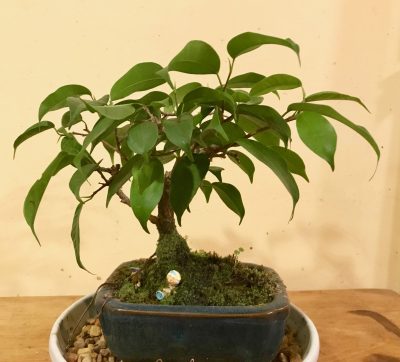
In its native habitat in the tropics, weeping fig grows to become a very large tree that rivals, in size, our maples. The effect is all the more dramatic due to thin aerial roots that drip from the branches, eventually fusing to create a massive, striated trunk. Because the tree tolerates low humidity, it’s often grown as a houseplant. Growth is rapid but with regular pruning the plant can be restrained below ceiling height.
At ten years old, my weeping fig is about four inches tall with a trunk about 5/8 inch in diameter and no aerial roots. Four inches was about the height of the plant when I purchased it in the houseplant section of a local lumberyard. Actually, four of these plants were growing in a 4 inch square pot. I separated them and potted one up with the idea of creating a bonsai.
The bonsai has been a success. Each year the trunk and stems have thickened to create the wizened appearance of a venerable old tree, in miniature. The soil beneath the spreading (if only 3 inch) limbs is soft with moss which has crept slowly up the lower portion of the trunk.
To Sleep, My Little Tree
Even after ten years the plant is in the same pot in which I originally planted it, a 4 by 6 inch bonsai tray only about an inch deep. Biannual repotting and pruning has been necessary to keep the stems and roots to size, and to refresh the potting soil to provide nutrients and room for roots to run (albeit very little room for a tree with such size potential).
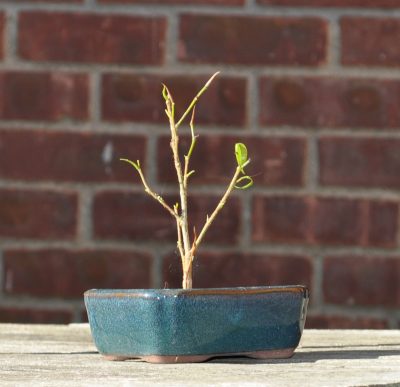
Back to my tree’s sleep: A few weeks ago, the sun dipping lower in the sky for a shorter time each day seemed to me like a good time to give the plant a rest, which it surely would be taking following my operation.
I began with the roots. After tipping the plant out of its pot, I used a fork to tease soil away from the bottom of the root ball. Roots left dangling down in mid air as I held the plant aloft were easy to trim back. I was careful to leave the top portion of the roots and soil undisturbed in order to keep the mossy blanket intact.

With enough fresh potting soil added to the pot so the tree (despite its size, I think I can call it a “tree”) would sit at the same height in the pot as previous to pruning, the tree was ready to return to its home. I firmed it in place.
Next, I turned to the above ground portions of the plant, beginning by pruning stems so the tree would look in proportion to the size of its container and to maintain the increasingly rugged look of a tree, in miniature, beyond its actual years.
Finally, I clipped each and every leaf from the plant. This shocks the plant to sleep and reduces water loss, important for a plant from which a fair share of its roots have been sheared off. Clipping off leaves also induces more diminutive growth in the next flush of leaves, so they are more in proportion to the size of the whole plant.
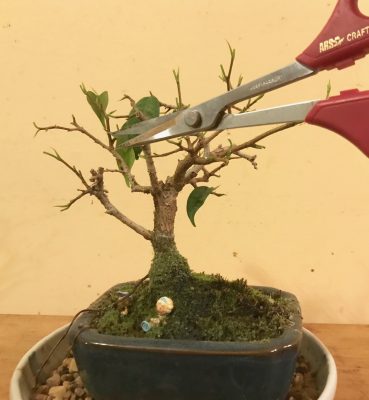
After a thorough watering, the tree was back in its sunny window. And there it sat, leafless, until a few days ago, when small, new leaves emerged.
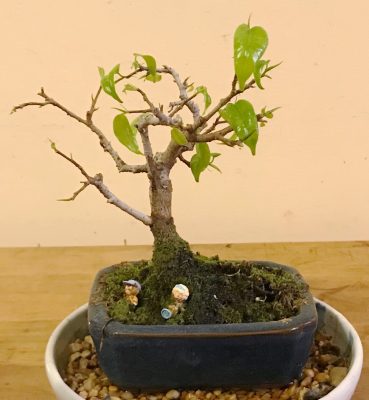
Pruning Moves Outdoors, Prematurely Perhaps
Pruning and repotting the bonsai wasn’t enough gardening for me. A couple of sunny days couldn’t help but drive me outdoors. A pile of wood chip mulch delivered a few months ago beckoned me; I spread it in the paths between my vegetable beds, a pre-emptive move to smother next season’s weeds.
I don’t usually prune this time of year (The Pruning Book, by me, recommends against it!), but couldn’t restrain myself. I started with the gooseberries and currants, both of which are super cold hardy plants so are unlikely to suffer any damage from pruning now. Plus, they start growth very early in spring.
Any of this gardening could be postponed until late winter or early spring. But why wait?

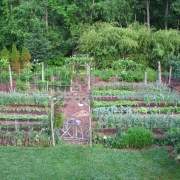

That is very impressive Lee. Years ago my husband (then my boyfriend) had one of these. I was not plant savvy, didn’t even own a plant book and killed it for him, I’m sure I overwatered it.
I also have a little bonsai ficus, a present that was probably purchased in a grocery store. I have had it for 2 I/2 years, still in its tiny pot. I periodically give it a little fish emulsion. It’s actually grown in height. I can’t bear to do any pruning, partly because I don’t think I’ll do a good job and I’ll wreck it. I secretly want to put it in a bigger pot and just let it grow. Would it do that?
Yes, put it into a bigger pot and it will grow bigger. And then a bigger pot . . .bigger. And . . .
I have several bonsai, some I’ve had for 30 or more years. Bonsai means “Tree in tray”, so technically, not all of mine are true bonsai, in bonsai pots. I got a dwarf sour cherry tree from Fedco, and the thing looked so little when it got delivered, that, yes, I put it in a pot. I didn’t have a chance to get it in the ground in the early fall like the company recommended, but I buried the pot in leaf compost, like my hardy bonsai, and am fairly confident it’ll come back in the spring.